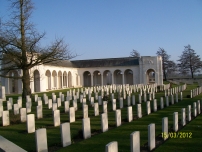| First Name: | Ebenezer | Last Name: | STEVENSON | |
|---|---|---|---|---|
| Date of Death: | 15/06/1915 | Lived/Born In: | Earlsfield | |
| Rank: | Private | Unit: | Yorkshire2 | |
| Memorial Site: | Le Touret Memorial, France | |||
Current Information:Age-34 Served as Frederick LORNE 62, Tranmere Road, Earlsfield
The Second Action of Givenchy, 15-16 June 1915 This was an attack by 7th Division, 51st Division and the Canadian Division to gain the high ground north of the La Bassée canal. The original plan called for an attack south of the canal as well but a shortage of artillery ammunition put paid to that. There was a slow bombardment of the enemy trenches for 48 hours but the artillery shortage meant that there was little covering fire for the actual attack and this was to have grave consequences. The enemy defences here were very strong and had been practically untouched by the British bombardment so when the assaulting troops rose from their trenches to attack they were met by a withering fire that decimated their ranks. Nevertheless some made it across to the German lines where a bombing fight took place. This was an unequal contest with the Germans having a better supply of more efficient grenades and inevitably the British were forced back to their own lines, leaving their dead behind. Undeterred by this setback exactly the same thing was tried again the next day with the same results. Just before 6pm on 15 June, 1915, the Royal Engineers blew a large mine at the Duck’s Bill, a stronghold in the German line and two minutes later the 2nd Yorkshire (Green Howards) and 2nd Wiltshire of 21 Brigade, 7th Division rose to the attack. They met heavy rifle and machine gun fire and were further impeded when they found that little of the wire had been cut. The enemy trenches were entered in places but no strong points captured and German resistance stiffened in the undamaged support trenches. The fight became one between bombers but German crossfire made it impossible to send reinforcements or supplies across no-man’s land. Both battalions suffered heavy casualties but the men fought on until finally the struggle became impossible to maintain and those who could fell back to their original positions. |
||||
| « Back to Search Results | ||||
| If you think any of the information shown here is incorrect, Click Here to submit your amends and comments | ||||




